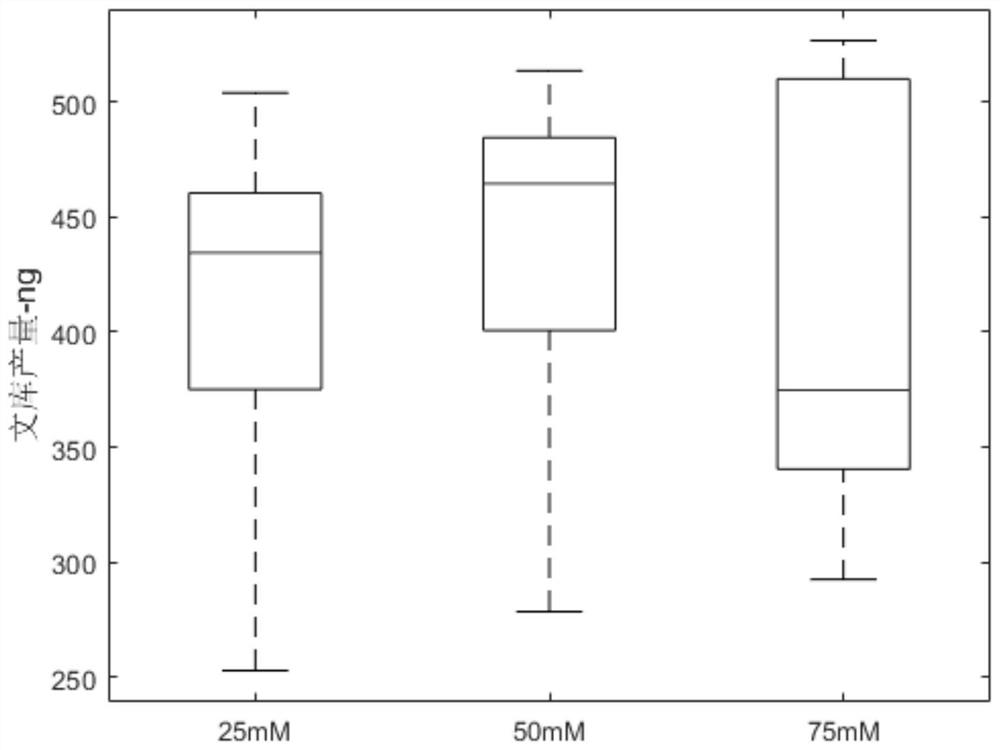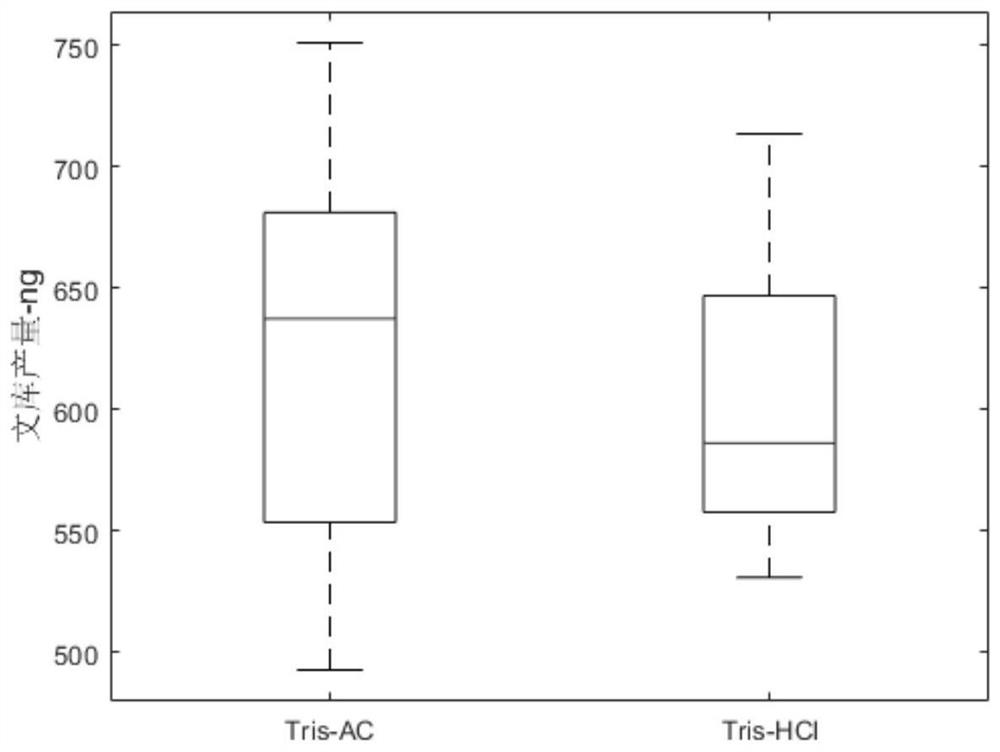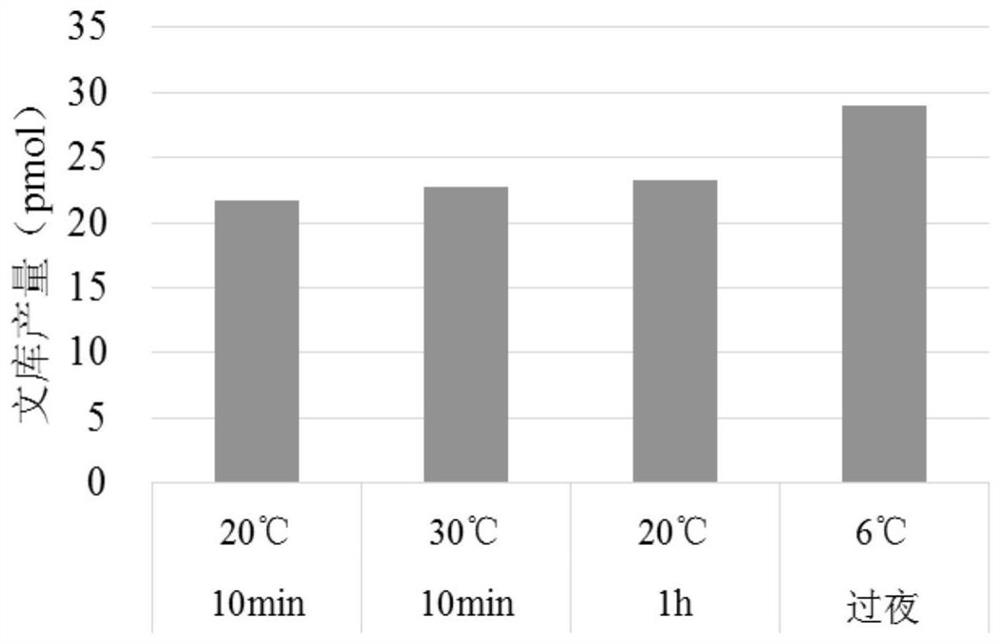Buffers and their applications
A technology of buffer and acetate buffer, which is applied in the field of joint connection buffer, buffer, and construction of nucleic acid library, which can solve the limitations of high-throughput workflow construction, limited height of the connection reaction plateau, and inability to advance the connection time, etc. problems, to achieve the effect of improving the efficiency of the ligation reaction, reducing the amount of enzyme used in the system, and having a small inhibitory effect
- Summary
- Abstract
- Description
- Claims
- Application Information
AI Technical Summary
Problems solved by technology
Method used
Image
Examples
Embodiment 1
[0075] In this example, the effect of different concentrations of monovalent cations on the yield of the library in the presence of PEG was studied according to the above general steps, wherein the composition of the ligation buffer was 45 mM Tris-AC buffer, 3 mM Mg 2+ 、Na + , 5mM dithiothreitol (DTT), 10% PEG4000-8000 and 1.5mM ATP, the pH value is 8. Wherein, the Na concentration in the connection buffer is as shown in Table 1, specifically as follows:
[0076] Table 1 Statistics of the number of linkers self-ligating under different Na+ concentrations
[0077]
[0078] As shown in Table 1, in the presence of 7.5% (w / v) PEG, the results are in line with the hypothesis. With the increase of Na+ concentration, the number of adapter self-associations decreased significantly, and the number of adapter self-associations decreased significantly in the presence of 37.5mM Na+. The number is about 4 times that of 50mM Na+, and the number of adapter self-ligations in the presence...
Embodiment 2
[0082] Since the negative ions of Tris-AC and Tris-HCl have different electronegativity, they have different effects on the interaction between enzymes and DNA, and the buffering capabilities of these two types are also different. Furthermore, in this example, T4 DNA connection is compared In the enzyme-mediated ligation reaction, the effect of Tris-AC and Tris-HCl buffer is carried out according to the above general steps. The composition of the ligation buffer is Tris-AC buffer, 3mM Mg 2+ , 50mM Na +, 5mM dithiothreitol (DTT), 10% PEG4000-8000 and 1.5mM ATP, the pH value is 8. Only for the Tris buffer in the connection buffer are Tris-AC and Tris-HCl respectively, the buffering effect of the buffer is as follows image 3 As shown, in the presence of 7.5% (w / v) PEG, Tris-AC has a wider fluctuation range, but has a positive effect on the increase of library yield.
Embodiment 3
[0084] In this example, according to the general method for constructing a nucleic acid library, the concentration of PEG in the ligation buffer was changed, and the effects of 7.5% and 10% PEG on library construction were compared, wherein the composition of the ligation buffer was 45 mM Tris-AC buffer, 3mMMg 2+ , 50mM Na + , 5mM dithiothreitol (DTT), PEG4000-8000 and 1.5mM ATP, the pH value is 8, specifically as follows:
[0085] Table 2 Library Yield Statistics at Different PEG Concentrations
[0086]
[0087] As shown in Table 2, when the concentration of PEG6000 is 10%, and the ligation time is 15 minutes, the library yield is 1.62 times that of 7.5% concentration. When the premix was prepared and left for 1 hour, the library yield under the condition of 10% PEG6000 was still higher than that under the condition of 7.5% PEG6000 concentration.
[0088] Wherein, it should be noted that 15 min refers to the ligation time of 15 min, and 15 min* means that the ligation r...
PUM
 Login to View More
Login to View More Abstract
Description
Claims
Application Information
 Login to View More
Login to View More - R&D
- Intellectual Property
- Life Sciences
- Materials
- Tech Scout
- Unparalleled Data Quality
- Higher Quality Content
- 60% Fewer Hallucinations
Browse by: Latest US Patents, China's latest patents, Technical Efficacy Thesaurus, Application Domain, Technology Topic, Popular Technical Reports.
© 2025 PatSnap. All rights reserved.Legal|Privacy policy|Modern Slavery Act Transparency Statement|Sitemap|About US| Contact US: help@patsnap.com



